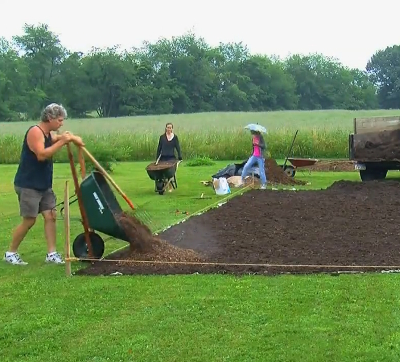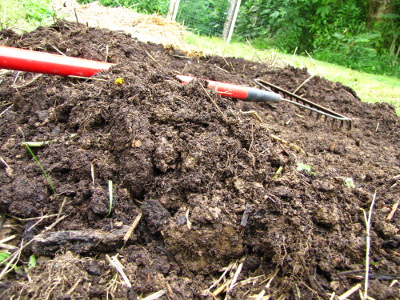
Cover crops in a Back to Eden garden
 "If you are fielding cover crop questions,
could you please speak to the compatibility of that concept with
no-till gardening (Back to Eden concept with wood chips). I live in the
north with great availability of wood chips. I'm not certain how to
combine the two methods. Thank you!"
"If you are fielding cover crop questions,
could you please speak to the compatibility of that concept with
no-till gardening (Back to Eden concept with wood chips). I live in the
north with great availability of wood chips. I'm not certain how to
combine the two methods. Thank you!"
For those unfamiliar
with the concept, the Back
to Eden system is similar to the the instant no-till techniques I
outline in Small-Scale No-Till
Gardening Basics (which is available in print as part of The Ultimate Guide to Soil).
Basically, you lay down a cardboard kill layer in new ground, top it
off with three to four inches of compost, then add wood chips on top as
mulch.
Okay, back to merryann's
question. It is tricky to choose cover crops
that suit no-till gardening, but luckily there are several that work
well once you weed out the problematic species. The tricky part is
making sure you select cover crops that are easy to kill, either with
winter cold (probably a good choice for you), mowing at bloom time, or
hand weeding out. My top choices given those
constraints are buckwheat for summer, oats and oilseed radishes for
late summer planting with optimal fall growth, and rye for full winter
and spring coverage.
 The only major difference between the Back to
Eden garden and my version of no-till from a cover-crop point of view
is using wood chips instead of straw for mulch. You'll want to rake
back the wood chips to expose bare ground before planting your cover
crops, and since wood chips will likely smother your seedlings in a way
straw won't I'd also rake
back a bit of the compost/topsoil as well. After sprinkling your
cover crop seeds, just pull the excess soil back over top (leaving the
wood chips along the edge of the bed) and you're good to go!
The only major difference between the Back to
Eden garden and my version of no-till from a cover-crop point of view
is using wood chips instead of straw for mulch. You'll want to rake
back the wood chips to expose bare ground before planting your cover
crops, and since wood chips will likely smother your seedlings in a way
straw won't I'd also rake
back a bit of the compost/topsoil as well. After sprinkling your
cover crop seeds, just pull the excess soil back over top (leaving the
wood chips along the edge of the bed) and you're good to go!
I'd love to see your
Back to Eden garden full of cover crops. I hope you'll drop back by
next year once you have photos to share!
Want more in-depth information? Browse through our books.
Or explore more posts by date or by subject.
About us: Anna Hess and Mark Hamilton spent over a decade living self-sufficiently in the mountains of Virginia before moving north to start over from scratch in the foothills of Ohio. They've experimented with permaculture, no-till gardening, trailersteading, home-based microbusinesses and much more, writing about their adventures in both blogs and books.
Want to be notified when new comments are posted on this page? Click on the RSS button after you add a comment to subscribe to the comment feed, or simply check the box beside "email replies to me" while writing your comment.
- Remove comment
- Remove comment
